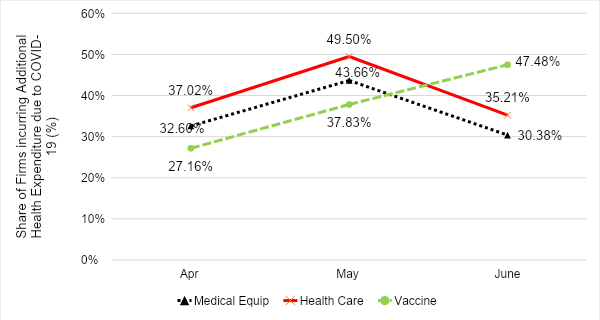Workplace as a Community: Businesses’ Response to the Market and Government Failures during COVID-19
12 Aug 2021
Opinion: Bornali Bhandari Samarth Gupta Ajaya K Sahu and KS Urs
The 2nd Covid-19 wave rose sharply from mid-March and peaked on 9th May 2021 (NCAER Quarterly Review of the Economy). The peak number of cases and deaths in second wave were four times higher than the peak in the first wave.
Daily deaths (7-day moving average) peaked at 4190 on 24th May 2021 compared to first wave peak of 1167 in September 2020. The sudden and unexpected surge in cases exposed the failures of markets as well as governments (economic inefficiency). While public sector capacity was overwhelmed market mechanisms became prohibitively expensive.
In those dreadful days however there were also instances where communities provided much needed relief for their members. While most expect community engagement to come from well-meaning neighbors non-profit organisations and religious institutions the role of a workplace as a shared community among employees has not been explored. Employees are one of the intangible assets for any firm.
Hence one expects businesses to step up and protect their workers. In this article we use NCAER’s Business Expectations Survey (N-BES) to explore different ways businesses may have curbed the impact on their employees during the second wave of COVID.
We asked firms about the additional health related expenditure they incurred for their employees between April and June 2021. This allowed us to observe the dynamics of business response with changing conditions during the second wave. Notably the firms we surveyed are located in 6 cities which accounted for 14 per cent of the total COVID-19 deaths in the country in June 2021 (Chennai Bengaluru Delhi Kolkata Mumbai & Pune).
If businesses do provide a shared community for their workers then the response should become sharper as the situation worsened between April and May and then subside with waning number of cases in June. Figure 1 provides summary of our findings.
How did firms help in protecting their workers?
- Expenditure on Medical Equipment such as Oxygen Cylinders etc. (dotted black line): Consistent with our expected view the proportion of firms incurring expenses on medical equipment for their employees increased from 33% to 44%. This proportion declines in June 2021 when the number of cases started coming down rapidly. Our further probing revealed that firms bought oximeters thermometer and sanitation machines.
- Expenditure on COVID-related treatment for employees (solid red line): A similar pattern as above is observed for expenditure on health treatment costs for employees infected with COVID. While 37% of businesses shared that they covered treatment costs for their employees in April 2021 nearly half the firms were doing so in the month after that. This proportion falls back to 35% in June 2021 when the incidence of cases declined. It is noteworthy that this expenditure is over and above health insurance coverage provided by employees. 88.3% of firms reported providing health insurance to permanent workers and 50% to temporary workers.
- Organising Vaccination Camps in Offices or Covering Vaccination Costs for Workers (dashed green line): The proportion of firms which organised vaccination camps or covered vaccination costs for employees increased substantially from 27% in April 2021 to 47% in June 2021. This increasing pattern is consistent with the expansion of pace in vaccination over these three months.
Expenditure on Health Care: April-June 2021

Source: NCAER Business Expectations Survey Round 117 July 2021.
These results imply that businesses and workers are not tied by merely transactional relationships. They protect their intangible assets in times of needs. In addition to health costs firms also provided food & residential services to workers (25.4% of firms in April 2021 34.2% in May 2021 and 20.7% in June 2021) and transport facilities to workers (35% of firms in April 2021 54.7% in May 2021 and 41.6% in June 2021).
What does this mean for public policy? First while nearly 88% of firms shared that they provided health insurance coverage to their permanent workers only half the firms did so for temporary workers. Government insurance program such as Ayushman Bharat can be offered through employers. This directly benefits workers and smaller firms especially who are burdened with elevated costs.
Rebates on employee provided health insurance to temporary workers may allow higher coverage of health risks. Second layoffs have been common among businesses. Information from businesses can serve as a data repository for extending government support to the laid-off workers in the form of unemployment insurance through Direct Benefit Transfer mechanism.
This will also enable more flexible labour market decisions for firms during future crises. Third in case of a third wave firms especially MSMEs could be reimbursed for their employees’ hospital bills or their hospital related expenditure can be made tax deductible. This could also have a direct impact on firms’ working capital.
Our findings compel us to re-position our understanding of relationship between firms and workers as not adversarial but that of a community where workers can seek solace and can be leveraged for purposes like re-skilling/upskilling.
The authors are Bornali Bhandari Senior Fellow NCAER. Samarth Gupta and KS Urs Associate Fellows NCAER AK Sahu Senior Research Analyst NCAER. Views are personal.
Published in: QRIUS , August 12, 2021






